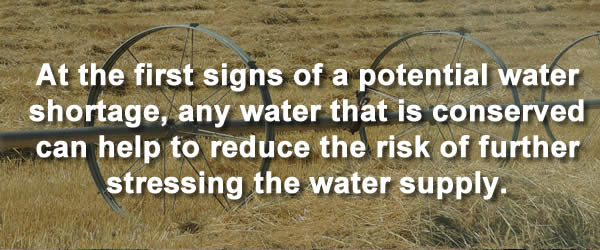
Water suppliers enact local drought stages based on current weather conditions, weather forecasts, water supply levels, and projected water demand.
When water supply is stressed, water suppliers may take the following measures to decrease water demand:
- Ask or require agricultural and domestic users to reduce water use through watering restrictions.
- During extreme drought, it may be necessary to implement early turn-off for agricultural customers.
LOCAL VS. PROVINCIAL DROUGHT RESPONSES:
Take action according to the drought response requested by YOUR local water supplier.
Local water supplier “drought stages” may differ from Provincial “drought levels” due to differences in local vs. regional drought.
Find drought management resources by commodity, below:
DURING A SEVERE DROUGHT:
When water supplies become critically low, drastic measures may be needed to reduce water use and prevent a complete loss of water supply.
Forage Crops
The B.C. Ministry of Agriculture has developed a series of factsheets that provide information on the choices you have when dealing with insufficient irrigation water supply.
The Key Drought Management Factsheet lists the following options:
- Schedule your irrigation to match soil moisture and evapotranspiration – Forage Crops and Irrigation Management in Drought Conditions
- Reduce the total irrigated acreage or the amount of irrigation per acre – Irrigation Decisions with Limited Water, Irrigated Alfalfa Management under Drought Conditions.
- Change to a lower water requirement crop when planting annual crops or re-seeding perennial crops – Alternate Forage Crops when Irrigation Water is Limited.
- Limit watering to the high-valuable perennial crops only.
Fertilizer management and weed control considerations also change during a drought. Plan your fertilizer program based on expected yields. Weed control is crucial when water is short as they compete with your crop for available water.
Resources:
Orchards and Vineyards
Drought during flower bud initiation in late summer can affect fruit yield for several years. The effects of drought during different times of the season will be different depending on the fruit trees’ or grapevines’ pattern of shoot and fruit growth.
The following strategies can result in decreased water losses in your orchard:
- Mulching can increase water infiltration rates, decrease soil temperatures, decrease evaporation, and reduce weed growth.
- Maximize the length of time between irrigations. This decreases water loss to evaporation.
- Irrigate at night and/or early in the morning – the cooler temperatures reduce evaporation.
- Reduce weed growth and active cover crop maintenance as they are competing for moisture with your fruit trees or grapevines.
- Reduce irrigation to less valuable varieties of your orchard or vineyard – if a block is reaching the end of its lifespan irrigation could be reduced in favour of younger more valuable plants.
Source: BC Tree Fruit Production Guide
Resources:
- Drought Assistance for Tree Fruit Production
- Irrigation Management of Winegrapes with a Limited Water Supply
- More Resources for Orchards and Vineyards
 Livestock
Livestock
Hot dry years not only affect the amount of high quality water that each animal requires, but may also result in damage to your rangeland or pasture.
Fire risk is also high during drought periods. Contact your Regional District or First Nations government to discuss Emergency Evacuation Plans for your livestock.
Resources:
- Livestock Management During Drought (FLNRORD)
- Rangeland Management During Drought (Agriculture and Agri-Food Canada)
- More Resources for Livestock
NEXT:

